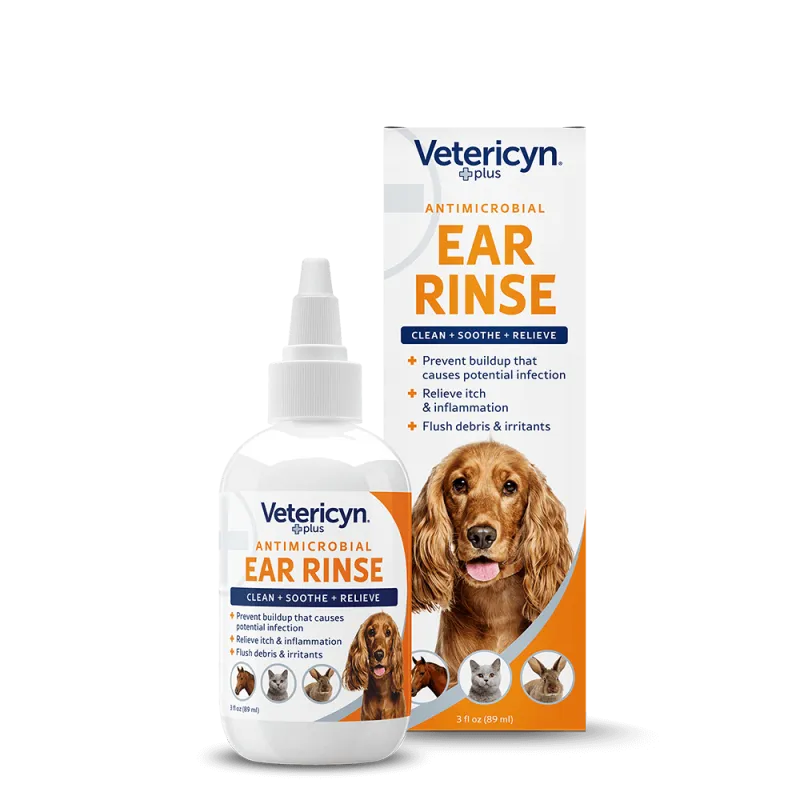Powered by Bestia Europe B.V.
Beagle Ear Problems: Common Issues and Solutions
They’re fun-loving, easygoing social butterflies who love to stir up mischief. That’s right—we’re talking about beagles, one of America’s most beloved dog breeds.
They’re all around adorable, but their cutest quality is undoubtedly their big, floppy ears. You know ‘em, you love ‘em, you need to clean ‘em. Sadly, their charming shape makes beagles prone to ear problems, especially painful canine ear infections.
For all you vigilant paw parents out there, a dog ear infection can be worrisome. Fortunately, with a little knowledge, doggy ear ailments are simple to spot and treat.
What Causes Ear Problems in Beagles?
So, why do those adorable ears cause trouble for your furry friend? For one, the dog’s ear canal happens to take a much more vertical shape in dogs than in humans (you can visualize it as an L-shaped tunnel).1
This L-shaped contour easily traps fluid and creates a cozy nook for yeast and bacteria to make camp, which can invite an inner ear infection.
For beagles, in particular, those cute tent-like ears completely cover the vertical ear canal. This blockage can:
- Cut off airflow
- Create the type of dark and moist environment that bacteria crave
Because the beagle ear canal is so hospitable to troublesome guests, a chronic ear infection is a common occurrence throughout the average beagle lifespan.
Additionally, beagles can develop ear troubles from:
- Wax accumulation
- Allergies
- Foreign bodies in the ear canal
- Ear mites
No matter the issue, the closed-off nature of beagles’ ear canals makes them tough to keep healthy.
Signs of Ear Issues
Is your beagle suddenly acting agitated or behaving strangely? These, among others, are a few telltale signs that your pup might be developing an ear issue or ear problem.
Watch for the following symptoms2:
- Scratching – Like humans, a dog’s natural reaction to itching or discomfort is to scratch. If you spot your pup frequently pawing at their ears, something may be up.
- Head shaking – Another common reaction to ear irritation is to shake the head side to side, as if they’re trying to dislodge something.
- Redness and swelling – You might notice red, inflamed skin around the ear or ear canal. This is a common sign that something is amiss.
- Scabbing – The presence of crusty scabs around the ear can be a symptom of bacterial infection.
- Excessive ear wax – Your dog’s immune system may attempt to expel invaders by balling them up in wax.
- Pus or smelly discharge – You may notice nasty fluid dripping from your dog’s ear—this is cause for investigation.
If you have beagles in your life, it’s advisable to keep a close eye on their ears and behavior. Catching an infection early is the best way to avoid deeper problems—and to spare your sweet furry friend some discomfort!
Types of Ear Infections
Not all ear issues are identical. Symptoms and treatment depend on the location of the problem.
There are three layers to the ear canal, and infections are named for where they show up1:
- Otitis externa – This is the most common infection and affects the outer ear.
- Otitis media – A middle ear infection that often stems from untreated otitis externa.
- Otitis interna – This occurs when the inner ear becomes irritated, but it’s generally rare in dogs.
Unfortunately, beagle ear problems won’t resolve on their own. If one or more of these symptoms are apparent in your beagle, it’s time to schedule a visit to the vet.

Treatment for Beagle Ear Troubles
After a careful examination, your vet’s first move will likely be to conduct an ear cytology. This is where they take a swab sample from the ear and test whether the infection stems from bacteria or fungus.3
Next, your vet will perform a thorough ear cleaning using medicated drops. This may require sedation, as your beagle is unlikely to appreciate the discomfort. If your vet doesn’t feel sedation is necessary, you can help keep your beagle calm by showing affection, using a soothing tone of voice, and feeding them treats.
After a cleaning and exam, there’s a few common treatment plans, depending on the type of ear issue.
Remedies include4:
- Topical therapy – Your vet may prescribe one of a variety of topical ointments, creams or drops to reduce inflammation and clear infection.
- Oral medications – Sometimes dogs need a little extra boost to fend off an infection. Oral treatment runs the gamut from steroids to antibiotics.
- Surgical intervention – Vets reserve surgery for more serious cases, especially of persistent otitis interna.
For otitis externa, the itching and discomfort can be extreme. Do your furry friend a favor: Give them some relief with a top notch soothing ointment. Vetericyn’s Triple Action Ear Treatment, equipped with 1% hydrocortisone, packs some serious soothing power.
For ear issues caused by wax buildup or a foreign object stuck in the ear canal, treatment will differ. In most cases, cleaning and removal of outside material will solve the problem.
Make sure to follow your vet’s instructions carefully and to complete the entire course of treatment, whatever they prescribe. It’s also important to remember that human medication designed to treat ear infections may be harmful to animals, so never use medication meant for people on your pup.5
How to Prevent Ear Issues
Although beagle ear problems are simple to treat, you also want to stop them from occurring in the first place. Taking preventative measures can save you a trip to the vet, and spare your furry friend quite a bit of unpleasantness.
The number one way to keep ears from getting irritated is to keep them clean and dry.
An excellent first step is to invest in a quality ear cleanser. A top notch ear cleaner, such as Vetericyn Plus Antimicrobial Ear Rinse, can help remove foreign debris, relieve itching, and generally keep the ear canal spick and span.
Once you have a cleanser picked out, it’s crucial to learn the correct cleaning technique.
How to Properly Clean a Dog’s Ears
For an effective and pain-free cleaning, take the following steps6:
- Assemble your tools – You should have a towel, cleanser, and cotton balls handy. It’s also wise to wear clothing you don’t mind getting messy, as most dogs won’t appreciate sitting still while you swab away at their ears.
- Get in the right position – It’s important to keep your pup calm and restrained during the cleaning process. Invite your beagle to lie down, then kneel beside them and use your arms to prevent them from rising.
- Apply the ear cleanser – Gently lift the ear flap until you can see inside the ear canal. Fill the ear canal completely with the fluid (until it overflows). Avoid inserting the bottle’s tip directly into the canal.
- Massage the ear – Hold the ear upright and gently massage around its base for 20-30 seconds. Massaging helps break up any wax or debris. After 30 seconds, allow your dog to get up and shake out the solution.
Once your beagle has shaken to their heart’s content, you’ll need to wipe away any excess fluid on their fur. Because this process can be messy, an outdoor setting is ideal.
Ear cleaning isn’t exactly a blast for your furry pal—don’t forget to reward them with a treat at the end!
How Often Should You Clean Your Dog’s Ears?
For a floppy-eared breed like beagles, it’s a good idea to perform a thorough cleaning once a month.7 This will help keep their ear canal problem-free.
It’s also wise to stay on top of grooming (this keeps ear hair from trapping debris) and to meticulously dry your dog’s ears after bathing or swimming.
For best results, make sure your beagle is in a calm state of mind before you start cleaning. If they are in an excitable mood, things are liable to get messy or take much longer than necessary.

What if Your Beagle Keeps Getting Ear Infections?
Even well-cared-for pups can come down with the occasional earache, so don’t worry too much if it’s a once-in-a-while thing.
But if you notice ear infections becoming a routine occurrence, there may be a deeper problem.
A few underlying health issues can trigger regular ear troubles. Some of these include:
- Endocrine disorders – This includes diseases like diabetes and hypothyroidism, which weaken your dog’s skin, making it more prone to inflammation.
- Environmental or food allergies – Allergic reactions can trigger skin inflammation and lead to ear infections.
- Ear mites – Mites more often affect cat ears, but they can pass to dogs. These pesky buggers itch like crazy, and the inevitable scratching can lead to infection.
Recurrent ear issues are no reason to panic, but they are a window into the deeper layers of your pet’s health. See them as an opportunity to tackle beagle health issues and troubles before they become major issues.
Veterycyn, For Pet-First Wellness
The best way to ensure a bouncy, boisterous beagle is to take a proactive approach to their health—and Veterycyn is here to help.
We’ve crafted our line of first-class animal wellness products with one goal in mind: help pets thrive. From our ALL-IN Dog Supplements, which are turbocharged with essential nutrients and loaded with human-grade digestive enzymes to our supremely soothing Hot Spot Antimicrobial Hydrogel, we’ve got what you need for an upbeat pup.
Discover how Vetericyn can support you and your pet today—explore our offerings today!
Sources:
- WebMD. Remedies for Dog Ear Infections. https://www.webmd.com/pets/dogs/remedies-for-dog-ear-infections
- MedVet. What You Need to Know About Ear Infections and Your Pet. https://www.medvet.com/ear-infections-and-your-pet/
- Media City Animal Hospital. Ear Cytology is the Standard of Care. https://www.mediacityvets.com/post/ear-cytology-is-the-standard-of-care
- PetMD. Dog Ear Infections. https://www.petmd.com/dog/conditions/dog-ear-infections#Go%20away
- AKC Pet Insurance. Dog Ear Infection Symptoms, Prevention, and Treatment. https://www.akcpetinsurance.com/blog/treating-and-preventing-ear-infections
- WebMD. How to Clean Dog Ears. https://www.webmd.com/pets/dogs/how-to-clean-dog-ears
- City Vet. How to Care for Your Dog’s Ears. https://www.cityvet.com/how-to-care-for-your-dogs-ears/
Refine by
Veterinarian Formula

Otic Care
Otic Care
Discover Vetericyn Plus VF Ophthalmic Wash: the most powerful solution for animal eye care and irritations.
€16,49

Vetericyn Plus All Animal Ear Rinse
Vetericyn Plus All Animal Ear Rinse
Remove unwanted substances. Relieves itching and irritation. Cleanses ears and removes odor.
€13,18

Vetericyn All Animal HydroGel Spray
Vetericyn All Animal HydroGel Spray
Soothing care for skin localized itching and skin problems.
€16,95

Vetericyn ALL-IN Senior Dog Supplements
Vetericyn ALL-IN Senior Dog Supplements
Mobility and rejuvenation. A formula protected by 8 patents. Proven absorption of the ingredients.
€28,88
Display prices in:EUR
